Business Context and Management Analysis Report for ASOS Company
VerifiedAdded on 2023/06/10
|14
|3234
|456
Report
AI Summary
This report provides a comprehensive business analysis of ASOS, a British fashion and cosmetic company operating through an online platform. The analysis begins with an industry trend analysis, examining the business cycle of ASOS, including its expansion and contraction phases influenced by economic factors. It then delves into an internal analysis using the VRIO framework to assess the value, rarity, imitability, and organization of ASOS's resources and capabilities. The report further explores operational management effectiveness, evaluating quality management and assurance, quality culture processes, and organizational leadership. It also applies the Kurt Lewin model to analyze change management within ASOS, focusing on unfreezing, change, and refreezing stages, and considers the influence of work culture on management decisions. Finally, a stakeholder analysis is conducted using a Power/Interest grid to identify and assess the engagement of ASOS's stakeholders. The report utilizes tools like OODA loop and TQM framework to provide insights into ASOS's strategic approaches and management practices.

BUSINESS CONTEXT AND
MANAGEMENT
MANAGEMENT
Paraphrase This Document
Need a fresh take? Get an instant paraphrase of this document with our AI Paraphraser
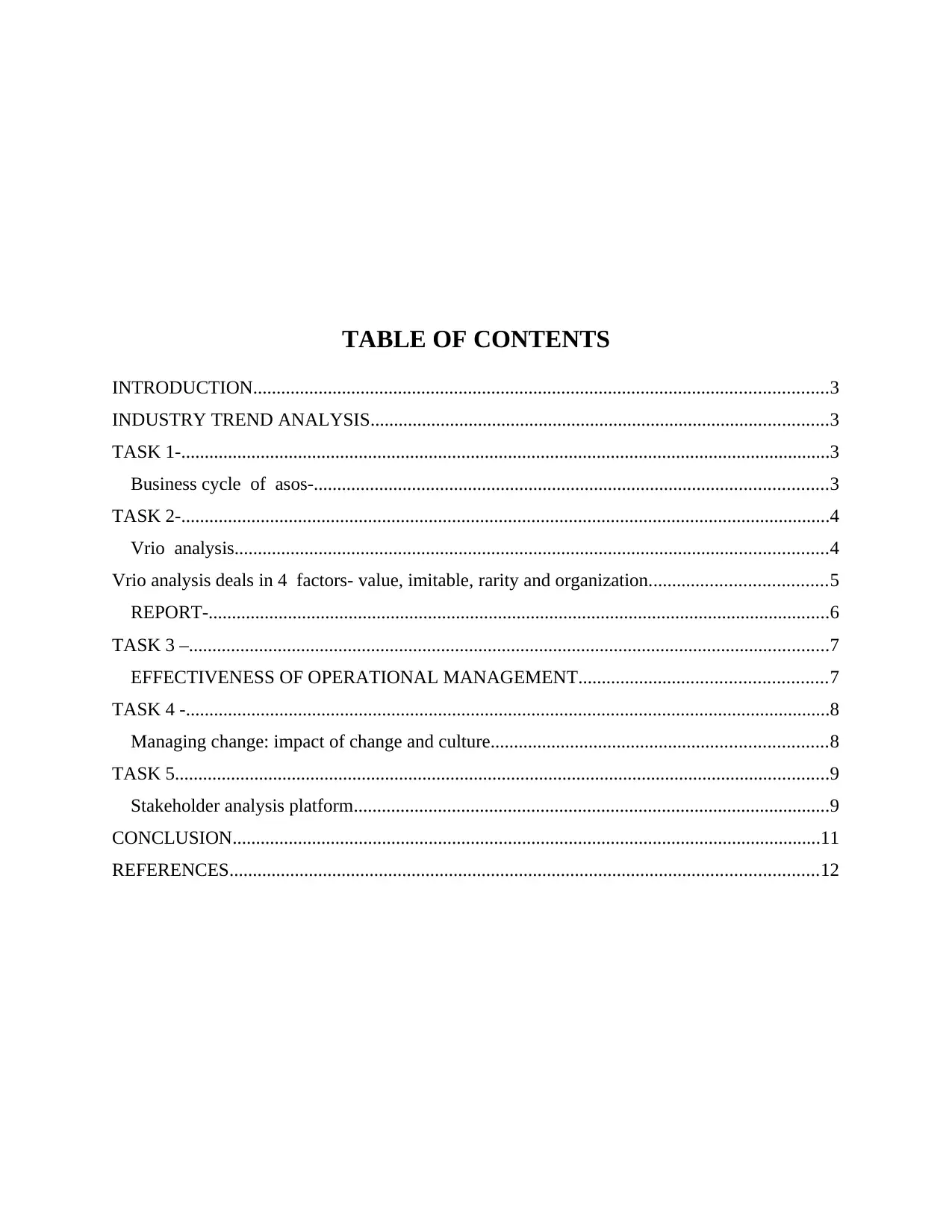
TABLE OF CONTENTS
INTRODUCTION...........................................................................................................................3
INDUSTRY TREND ANALYSIS..................................................................................................3
TASK 1-...........................................................................................................................................3
Business cycle of asos-..............................................................................................................3
TASK 2-...........................................................................................................................................4
Vrio analysis...............................................................................................................................4
Vrio analysis deals in 4 factors- value, imitable, rarity and organization......................................5
REPORT-.....................................................................................................................................6
TASK 3 –.........................................................................................................................................7
EFFECTIVENESS OF OPERATIONAL MANAGEMENT.....................................................7
TASK 4 -..........................................................................................................................................8
Managing change: impact of change and culture........................................................................8
TASK 5............................................................................................................................................9
Stakeholder analysis platform......................................................................................................9
CONCLUSION..............................................................................................................................11
REFERENCES..............................................................................................................................12
INTRODUCTION...........................................................................................................................3
INDUSTRY TREND ANALYSIS..................................................................................................3
TASK 1-...........................................................................................................................................3
Business cycle of asos-..............................................................................................................3
TASK 2-...........................................................................................................................................4
Vrio analysis...............................................................................................................................4
Vrio analysis deals in 4 factors- value, imitable, rarity and organization......................................5
REPORT-.....................................................................................................................................6
TASK 3 –.........................................................................................................................................7
EFFECTIVENESS OF OPERATIONAL MANAGEMENT.....................................................7
TASK 4 -..........................................................................................................................................8
Managing change: impact of change and culture........................................................................8
TASK 5............................................................................................................................................9
Stakeholder analysis platform......................................................................................................9
CONCLUSION..............................................................................................................................11
REFERENCES..............................................................................................................................12

INTRODUCTION
Asos is a British fashion and cosmetic company, operating business through its online
platform with a widespread network. Its name stands for AS SEEN ON SCREEN , with a tag-
line stating, “buy what is seen in films and TV”. The brand expanded globally in the 2010s and
has 850 brands on the site, including its own recognized label. It has also started its new line in
home appliances and furniture.
Following report provides an insight on the management practices that are used against the
business context challenges and determining an alternative strategy with the help of some tools
and analysis.
INDUSTRY TREND ANALYSIS
There are various factors that affects a business, So, a right understanding of the business
environment helps the owner, make right decisions for the organization (Pantano and Vannucci,
2019). It is very crucial to know the external environment of a business because, in that way one
can postulate, when it is the right time to gear up a contraction and take the benefit of expansion.
The business cycle of any business is smitten by the economic factors which has a direct
influence on the economy. It includes all the aspects such as the demand, supply, cost of
production and every other factor.
TASK 1-
Business cycle of asos-
EXPANSION
The business is tending to achieve a
CONTRACTION
Asos reported a sharp slow-down in
Asos is a British fashion and cosmetic company, operating business through its online
platform with a widespread network. Its name stands for AS SEEN ON SCREEN , with a tag-
line stating, “buy what is seen in films and TV”. The brand expanded globally in the 2010s and
has 850 brands on the site, including its own recognized label. It has also started its new line in
home appliances and furniture.
Following report provides an insight on the management practices that are used against the
business context challenges and determining an alternative strategy with the help of some tools
and analysis.
INDUSTRY TREND ANALYSIS
There are various factors that affects a business, So, a right understanding of the business
environment helps the owner, make right decisions for the organization (Pantano and Vannucci,
2019). It is very crucial to know the external environment of a business because, in that way one
can postulate, when it is the right time to gear up a contraction and take the benefit of expansion.
The business cycle of any business is smitten by the economic factors which has a direct
influence on the economy. It includes all the aspects such as the demand, supply, cost of
production and every other factor.
TASK 1-
Business cycle of asos-
EXPANSION
The business is tending to achieve a
CONTRACTION
Asos reported a sharp slow-down in
⊘ This is a preview!⊘
Do you want full access?
Subscribe today to unlock all pages.

Trusted by 1+ million students worldwide
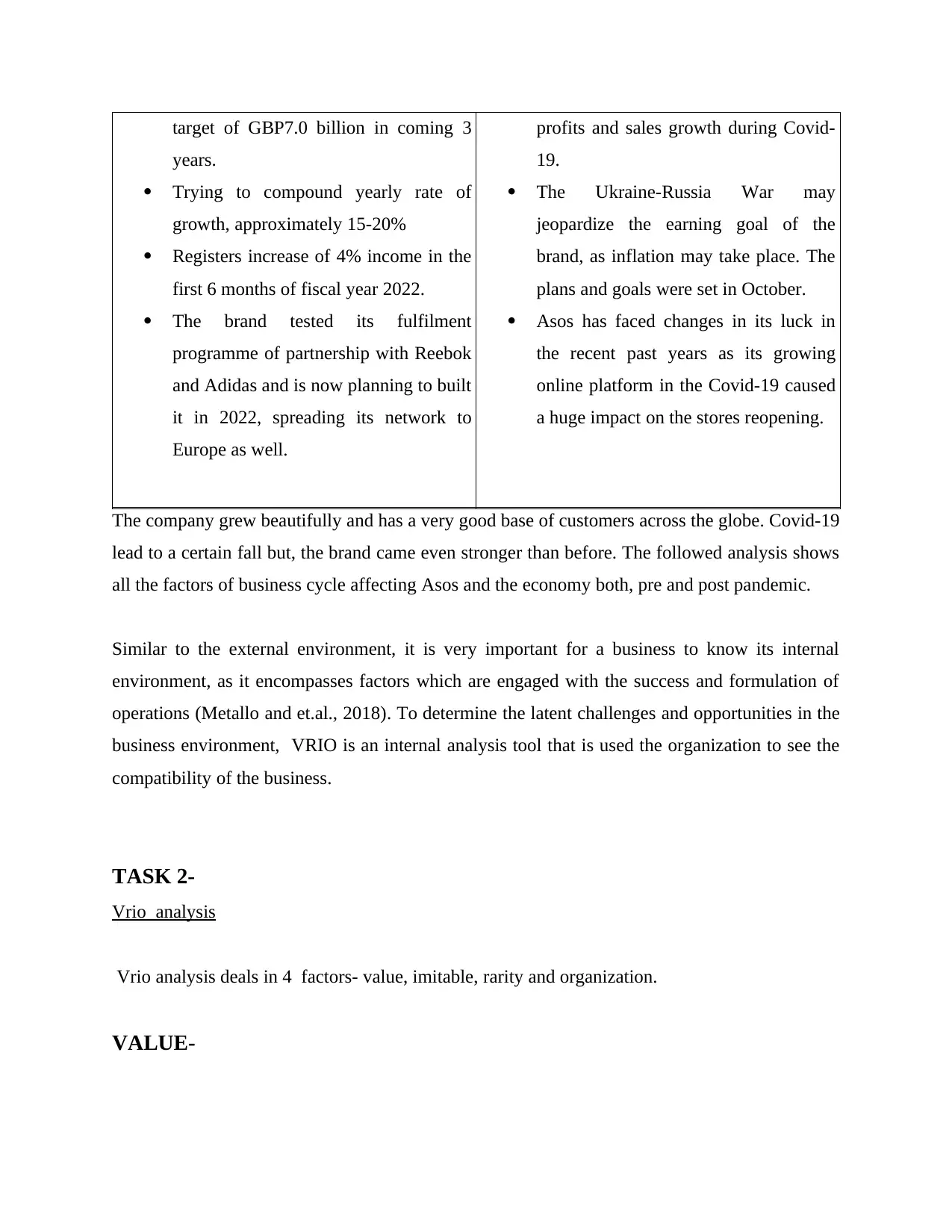
target of GBP7.0 billion in coming 3
years.
Trying to compound yearly rate of
growth, approximately 15-20%
Registers increase of 4% income in the
first 6 months of fiscal year 2022.
The brand tested its fulfilment
programme of partnership with Reebok
and Adidas and is now planning to built
it in 2022, spreading its network to
Europe as well.
profits and sales growth during Covid-
19.
The Ukraine-Russia War may
jeopardize the earning goal of the
brand, as inflation may take place. The
plans and goals were set in October.
Asos has faced changes in its luck in
the recent past years as its growing
online platform in the Covid-19 caused
a huge impact on the stores reopening.
The company grew beautifully and has a very good base of customers across the globe. Covid-19
lead to a certain fall but, the brand came even stronger than before. The followed analysis shows
all the factors of business cycle affecting Asos and the economy both, pre and post pandemic.
Similar to the external environment, it is very important for a business to know its internal
environment, as it encompasses factors which are engaged with the success and formulation of
operations (Metallo and et.al., 2018). To determine the latent challenges and opportunities in the
business environment, VRIO is an internal analysis tool that is used the organization to see the
compatibility of the business.
TASK 2-
Vrio analysis
Vrio analysis deals in 4 factors- value, imitable, rarity and organization.
VALUE-
years.
Trying to compound yearly rate of
growth, approximately 15-20%
Registers increase of 4% income in the
first 6 months of fiscal year 2022.
The brand tested its fulfilment
programme of partnership with Reebok
and Adidas and is now planning to built
it in 2022, spreading its network to
Europe as well.
profits and sales growth during Covid-
19.
The Ukraine-Russia War may
jeopardize the earning goal of the
brand, as inflation may take place. The
plans and goals were set in October.
Asos has faced changes in its luck in
the recent past years as its growing
online platform in the Covid-19 caused
a huge impact on the stores reopening.
The company grew beautifully and has a very good base of customers across the globe. Covid-19
lead to a certain fall but, the brand came even stronger than before. The followed analysis shows
all the factors of business cycle affecting Asos and the economy both, pre and post pandemic.
Similar to the external environment, it is very important for a business to know its internal
environment, as it encompasses factors which are engaged with the success and formulation of
operations (Metallo and et.al., 2018). To determine the latent challenges and opportunities in the
business environment, VRIO is an internal analysis tool that is used the organization to see the
compatibility of the business.
TASK 2-
Vrio analysis
Vrio analysis deals in 4 factors- value, imitable, rarity and organization.
VALUE-
Paraphrase This Document
Need a fresh take? Get an instant paraphrase of this document with our AI Paraphraser
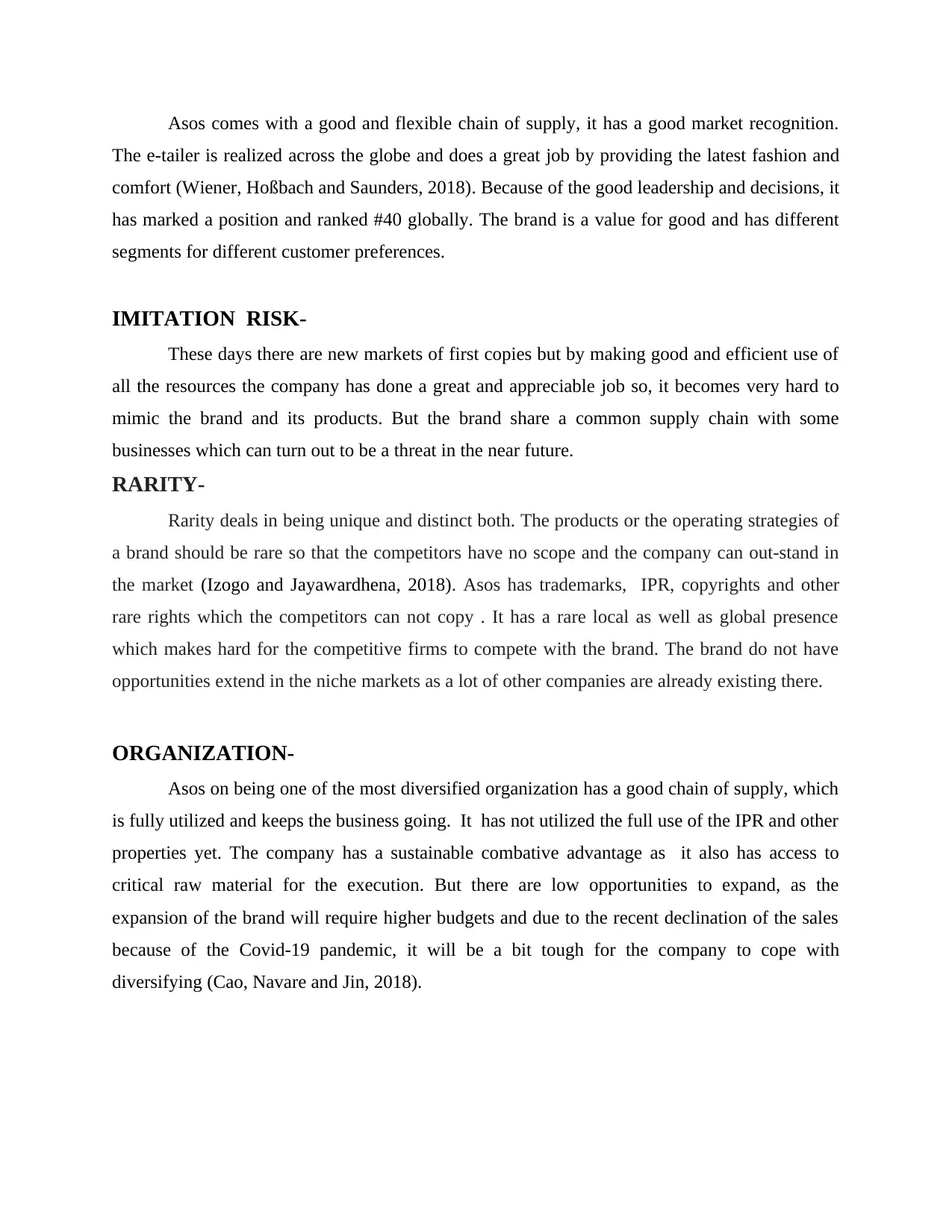
Asos comes with a good and flexible chain of supply, it has a good market recognition.
The e-tailer is realized across the globe and does a great job by providing the latest fashion and
comfort (Wiener, Hoßbach and Saunders, 2018). Because of the good leadership and decisions, it
has marked a position and ranked #40 globally. The brand is a value for good and has different
segments for different customer preferences.
IMITATION RISK-
These days there are new markets of first copies but by making good and efficient use of
all the resources the company has done a great and appreciable job so, it becomes very hard to
mimic the brand and its products. But the brand share a common supply chain with some
businesses which can turn out to be a threat in the near future.
RARITY-
Rarity deals in being unique and distinct both. The products or the operating strategies of
a brand should be rare so that the competitors have no scope and the company can out-stand in
the market (Izogo and Jayawardhena, 2018). Asos has trademarks, IPR, copyrights and other
rare rights which the competitors can not copy . It has a rare local as well as global presence
which makes hard for the competitive firms to compete with the brand. The brand do not have
opportunities extend in the niche markets as a lot of other companies are already existing there.
ORGANIZATION-
Asos on being one of the most diversified organization has a good chain of supply, which
is fully utilized and keeps the business going. It has not utilized the full use of the IPR and other
properties yet. The company has a sustainable combative advantage as it also has access to
critical raw material for the execution. But there are low opportunities to expand, as the
expansion of the brand will require higher budgets and due to the recent declination of the sales
because of the Covid-19 pandemic, it will be a bit tough for the company to cope with
diversifying (Cao, Navare and Jin, 2018).
The e-tailer is realized across the globe and does a great job by providing the latest fashion and
comfort (Wiener, Hoßbach and Saunders, 2018). Because of the good leadership and decisions, it
has marked a position and ranked #40 globally. The brand is a value for good and has different
segments for different customer preferences.
IMITATION RISK-
These days there are new markets of first copies but by making good and efficient use of
all the resources the company has done a great and appreciable job so, it becomes very hard to
mimic the brand and its products. But the brand share a common supply chain with some
businesses which can turn out to be a threat in the near future.
RARITY-
Rarity deals in being unique and distinct both. The products or the operating strategies of
a brand should be rare so that the competitors have no scope and the company can out-stand in
the market (Izogo and Jayawardhena, 2018). Asos has trademarks, IPR, copyrights and other
rare rights which the competitors can not copy . It has a rare local as well as global presence
which makes hard for the competitive firms to compete with the brand. The brand do not have
opportunities extend in the niche markets as a lot of other companies are already existing there.
ORGANIZATION-
Asos on being one of the most diversified organization has a good chain of supply, which
is fully utilized and keeps the business going. It has not utilized the full use of the IPR and other
properties yet. The company has a sustainable combative advantage as it also has access to
critical raw material for the execution. But there are low opportunities to expand, as the
expansion of the brand will require higher budgets and due to the recent declination of the sales
because of the Covid-19 pandemic, it will be a bit tough for the company to cope with
diversifying (Cao, Navare and Jin, 2018).

REPORT-
Here is the report on all the business analysis done on the Asos company showing the
impacts of all the external and internal environment of the industry.
Planning right, leads to the right structure of a company. In order to attain growth it is very
important for a company to strategically design and execute its plans as it helps to increase
functional efficiency, increase profitability and makes a company become more durable by
giving a sense of direction (Nash, 2018).
This report is made using the OODA LOOP, which is a 4 step approach that helps in better
understanding and decision makings.
It includes observing, orienting, deciding, and then acting.
OBSERVATIONS-
The company is a diversified organization which has an established customer base,
globally. It is growing beautifully and deals in fashionable clothing and cosmetics. The brand
focuses on increasing its sales every minute and during pandemic, it faced huge increment in
sales through its online platform.
ORIENTATION-
Before the Covid-19 the brand was doing good, but during the pandemic it observed a
rapid growth in its sales, as the demand for online shopping increased. The brand has now spread
its network even more and is reopening its stores offline in different places. It has also made a
decision of partnership with Anti-Slavery International.
DECISIONS-
The brand is now also partnering with other brands to make new standards of fashion
and expand its operations. It has taken decisions on testing its partnership with Adidas and
Reebok and then building on it (Li, 2020).
ACTING-
Here is the report on all the business analysis done on the Asos company showing the
impacts of all the external and internal environment of the industry.
Planning right, leads to the right structure of a company. In order to attain growth it is very
important for a company to strategically design and execute its plans as it helps to increase
functional efficiency, increase profitability and makes a company become more durable by
giving a sense of direction (Nash, 2018).
This report is made using the OODA LOOP, which is a 4 step approach that helps in better
understanding and decision makings.
It includes observing, orienting, deciding, and then acting.
OBSERVATIONS-
The company is a diversified organization which has an established customer base,
globally. It is growing beautifully and deals in fashionable clothing and cosmetics. The brand
focuses on increasing its sales every minute and during pandemic, it faced huge increment in
sales through its online platform.
ORIENTATION-
Before the Covid-19 the brand was doing good, but during the pandemic it observed a
rapid growth in its sales, as the demand for online shopping increased. The brand has now spread
its network even more and is reopening its stores offline in different places. It has also made a
decision of partnership with Anti-Slavery International.
DECISIONS-
The brand is now also partnering with other brands to make new standards of fashion
and expand its operations. It has taken decisions on testing its partnership with Adidas and
Reebok and then building on it (Li, 2020).
ACTING-
⊘ This is a preview!⊘
Do you want full access?
Subscribe today to unlock all pages.

Trusted by 1+ million students worldwide
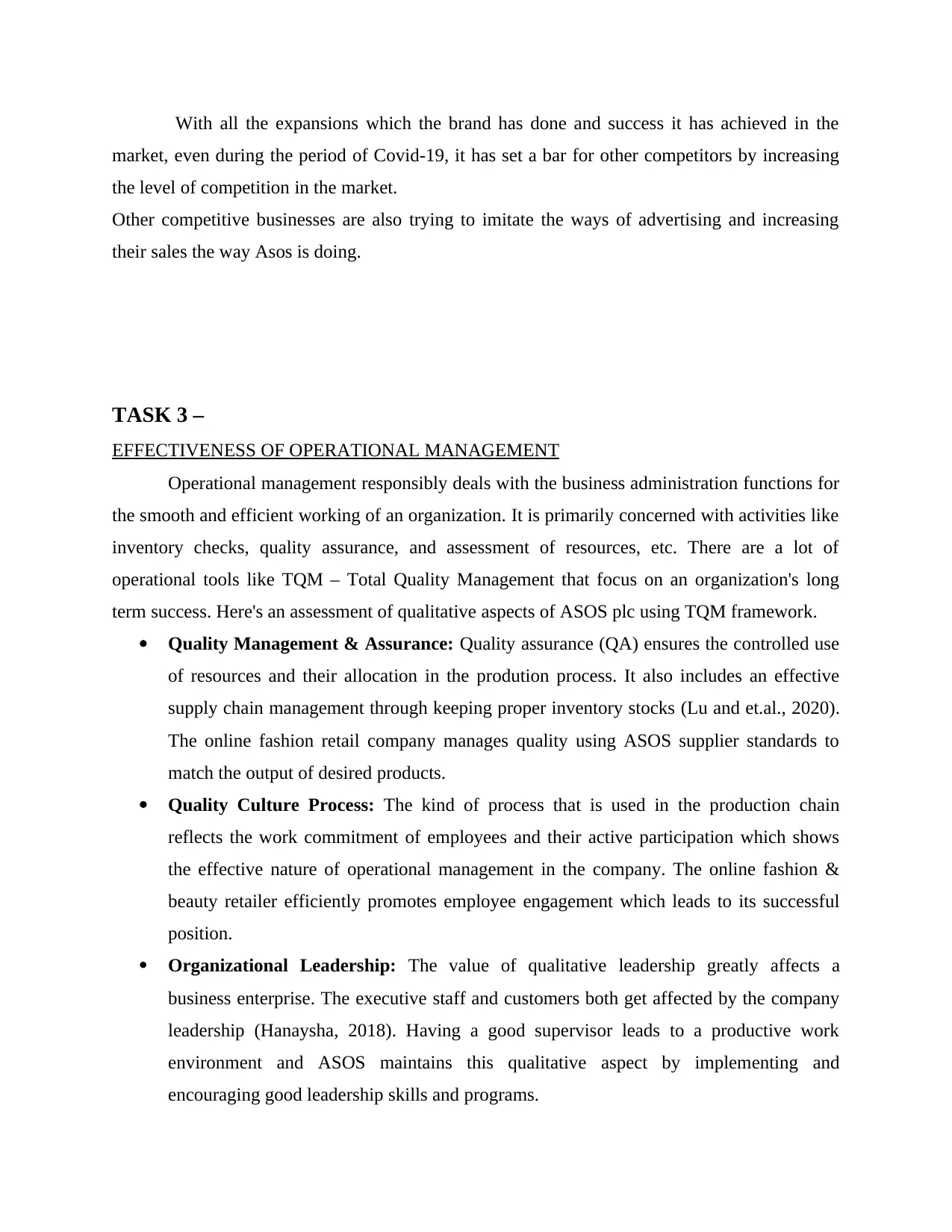
With all the expansions which the brand has done and success it has achieved in the
market, even during the period of Covid-19, it has set a bar for other competitors by increasing
the level of competition in the market.
Other competitive businesses are also trying to imitate the ways of advertising and increasing
their sales the way Asos is doing.
TASK 3 –
EFFECTIVENESS OF OPERATIONAL MANAGEMENT
Operational management responsibly deals with the business administration functions for
the smooth and efficient working of an organization. It is primarily concerned with activities like
inventory checks, quality assurance, and assessment of resources, etc. There are a lot of
operational tools like TQM – Total Quality Management that focus on an organization's long
term success. Here's an assessment of qualitative aspects of ASOS plc using TQM framework.
Quality Management & Assurance: Quality assurance (QA) ensures the controlled use
of resources and their allocation in the prodution process. It also includes an effective
supply chain management through keeping proper inventory stocks (Lu and et.al., 2020).
The online fashion retail company manages quality using ASOS supplier standards to
match the output of desired products.
Quality Culture Process: The kind of process that is used in the production chain
reflects the work commitment of employees and their active participation which shows
the effective nature of operational management in the company. The online fashion &
beauty retailer efficiently promotes employee engagement which leads to its successful
position.
Organizational Leadership: The value of qualitative leadership greatly affects a
business enterprise. The executive staff and customers both get affected by the company
leadership (Hanaysha, 2018). Having a good supervisor leads to a productive work
environment and ASOS maintains this qualitative aspect by implementing and
encouraging good leadership skills and programs.
market, even during the period of Covid-19, it has set a bar for other competitors by increasing
the level of competition in the market.
Other competitive businesses are also trying to imitate the ways of advertising and increasing
their sales the way Asos is doing.
TASK 3 –
EFFECTIVENESS OF OPERATIONAL MANAGEMENT
Operational management responsibly deals with the business administration functions for
the smooth and efficient working of an organization. It is primarily concerned with activities like
inventory checks, quality assurance, and assessment of resources, etc. There are a lot of
operational tools like TQM – Total Quality Management that focus on an organization's long
term success. Here's an assessment of qualitative aspects of ASOS plc using TQM framework.
Quality Management & Assurance: Quality assurance (QA) ensures the controlled use
of resources and their allocation in the prodution process. It also includes an effective
supply chain management through keeping proper inventory stocks (Lu and et.al., 2020).
The online fashion retail company manages quality using ASOS supplier standards to
match the output of desired products.
Quality Culture Process: The kind of process that is used in the production chain
reflects the work commitment of employees and their active participation which shows
the effective nature of operational management in the company. The online fashion &
beauty retailer efficiently promotes employee engagement which leads to its successful
position.
Organizational Leadership: The value of qualitative leadership greatly affects a
business enterprise. The executive staff and customers both get affected by the company
leadership (Hanaysha, 2018). Having a good supervisor leads to a productive work
environment and ASOS maintains this qualitative aspect by implementing and
encouraging good leadership skills and programs.
Paraphrase This Document
Need a fresh take? Get an instant paraphrase of this document with our AI Paraphraser
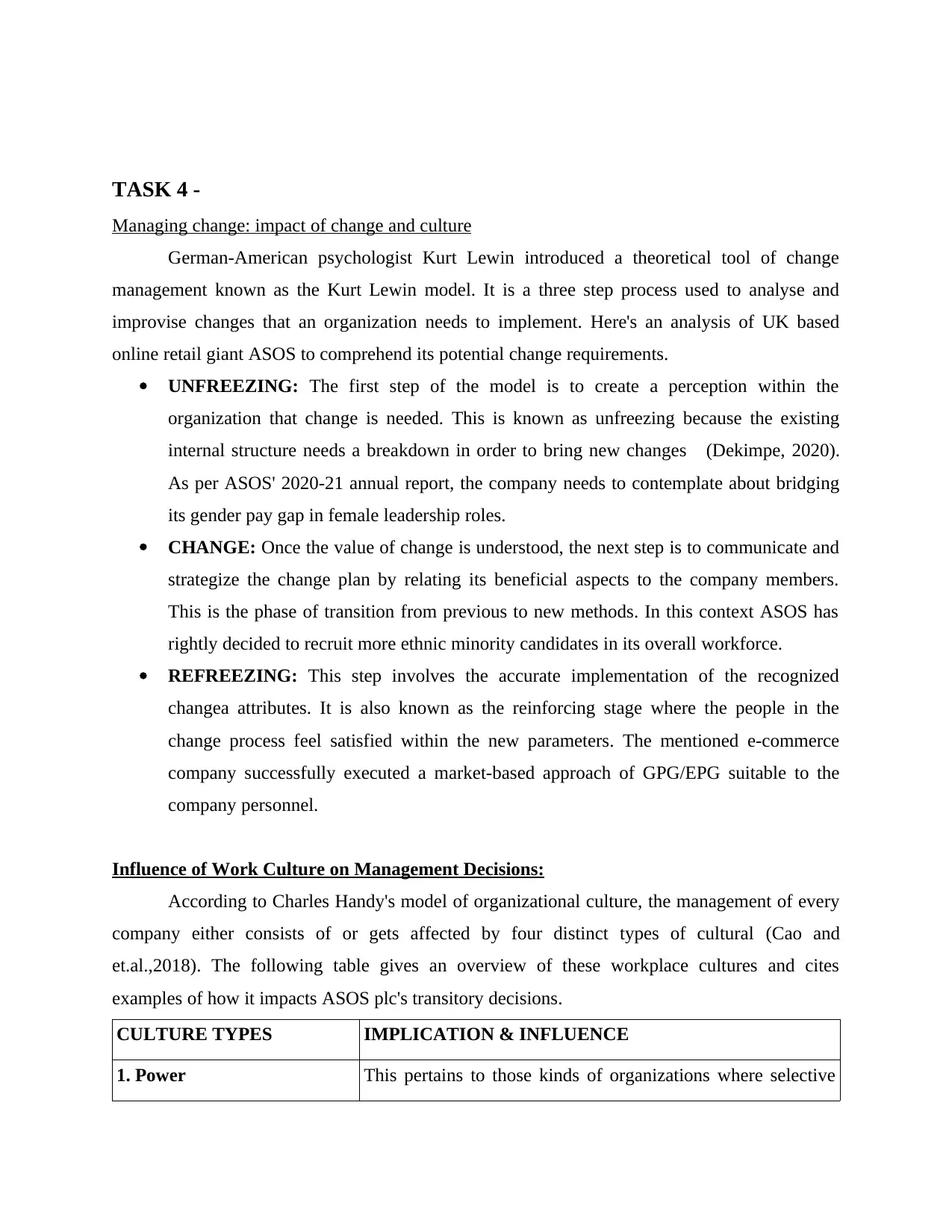
TASK 4 -
Managing change: impact of change and culture
German-American psychologist Kurt Lewin introduced a theoretical tool of change
management known as the Kurt Lewin model. It is a three step process used to analyse and
improvise changes that an organization needs to implement. Here's an analysis of UK based
online retail giant ASOS to comprehend its potential change requirements.
UNFREEZING: The first step of the model is to create a perception within the
organization that change is needed. This is known as unfreezing because the existing
internal structure needs a breakdown in order to bring new changes (Dekimpe, 2020).
As per ASOS' 2020-21 annual report, the company needs to contemplate about bridging
its gender pay gap in female leadership roles.
CHANGE: Once the value of change is understood, the next step is to communicate and
strategize the change plan by relating its beneficial aspects to the company members.
This is the phase of transition from previous to new methods. In this context ASOS has
rightly decided to recruit more ethnic minority candidates in its overall workforce.
REFREEZING: This step involves the accurate implementation of the recognized
changea attributes. It is also known as the reinforcing stage where the people in the
change process feel satisfied within the new parameters. The mentioned e-commerce
company successfully executed a market-based approach of GPG/EPG suitable to the
company personnel.
Influence of Work Culture on Management Decisions:
According to Charles Handy's model of organizational culture, the management of every
company either consists of or gets affected by four distinct types of cultural (Cao and
et.al.,2018). The following table gives an overview of these workplace cultures and cites
examples of how it impacts ASOS plc's transitory decisions.
CULTURE TYPES IMPLICATION & INFLUENCE
1. Power This pertains to those kinds of organizations where selective
Managing change: impact of change and culture
German-American psychologist Kurt Lewin introduced a theoretical tool of change
management known as the Kurt Lewin model. It is a three step process used to analyse and
improvise changes that an organization needs to implement. Here's an analysis of UK based
online retail giant ASOS to comprehend its potential change requirements.
UNFREEZING: The first step of the model is to create a perception within the
organization that change is needed. This is known as unfreezing because the existing
internal structure needs a breakdown in order to bring new changes (Dekimpe, 2020).
As per ASOS' 2020-21 annual report, the company needs to contemplate about bridging
its gender pay gap in female leadership roles.
CHANGE: Once the value of change is understood, the next step is to communicate and
strategize the change plan by relating its beneficial aspects to the company members.
This is the phase of transition from previous to new methods. In this context ASOS has
rightly decided to recruit more ethnic minority candidates in its overall workforce.
REFREEZING: This step involves the accurate implementation of the recognized
changea attributes. It is also known as the reinforcing stage where the people in the
change process feel satisfied within the new parameters. The mentioned e-commerce
company successfully executed a market-based approach of GPG/EPG suitable to the
company personnel.
Influence of Work Culture on Management Decisions:
According to Charles Handy's model of organizational culture, the management of every
company either consists of or gets affected by four distinct types of cultural (Cao and
et.al.,2018). The following table gives an overview of these workplace cultures and cites
examples of how it impacts ASOS plc's transitory decisions.
CULTURE TYPES IMPLICATION & INFLUENCE
1. Power This pertains to those kinds of organizations where selective
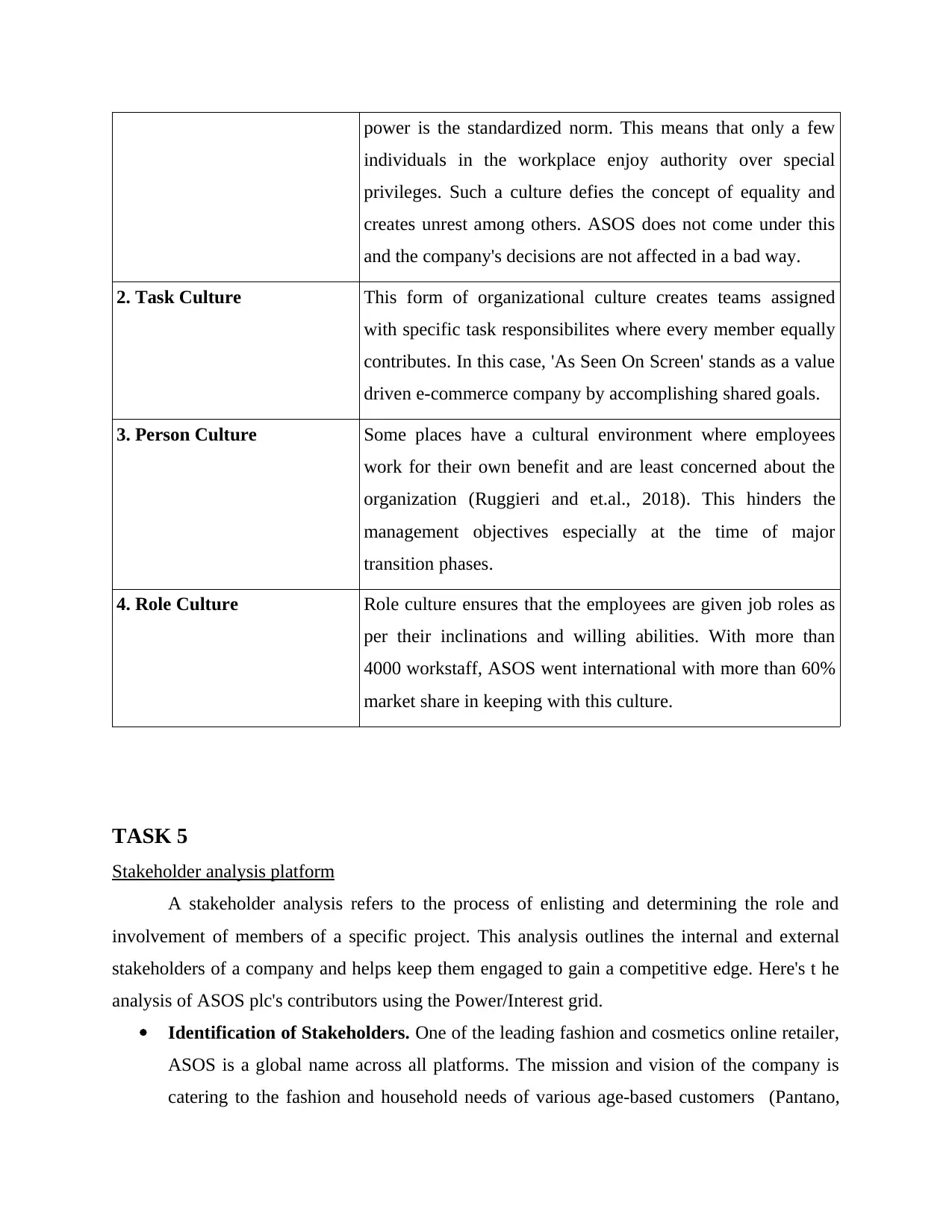
power is the standardized norm. This means that only a few
individuals in the workplace enjoy authority over special
privileges. Such a culture defies the concept of equality and
creates unrest among others. ASOS does not come under this
and the company's decisions are not affected in a bad way.
2. Task Culture This form of organizational culture creates teams assigned
with specific task responsibilites where every member equally
contributes. In this case, 'As Seen On Screen' stands as a value
driven e-commerce company by accomplishing shared goals.
3. Person Culture Some places have a cultural environment where employees
work for their own benefit and are least concerned about the
organization (Ruggieri and et.al., 2018). This hinders the
management objectives especially at the time of major
transition phases.
4. Role Culture Role culture ensures that the employees are given job roles as
per their inclinations and willing abilities. With more than
4000 workstaff, ASOS went international with more than 60%
market share in keeping with this culture.
TASK 5
Stakeholder analysis platform
A stakeholder analysis refers to the process of enlisting and determining the role and
involvement of members of a specific project. This analysis outlines the internal and external
stakeholders of a company and helps keep them engaged to gain a competitive edge. Here's t he
analysis of ASOS plc's contributors using the Power/Interest grid.
Identification of Stakeholders. One of the leading fashion and cosmetics online retailer,
ASOS is a global name across all platforms. The mission and vision of the company is
catering to the fashion and household needs of various age-based customers (Pantano,
individuals in the workplace enjoy authority over special
privileges. Such a culture defies the concept of equality and
creates unrest among others. ASOS does not come under this
and the company's decisions are not affected in a bad way.
2. Task Culture This form of organizational culture creates teams assigned
with specific task responsibilites where every member equally
contributes. In this case, 'As Seen On Screen' stands as a value
driven e-commerce company by accomplishing shared goals.
3. Person Culture Some places have a cultural environment where employees
work for their own benefit and are least concerned about the
organization (Ruggieri and et.al., 2018). This hinders the
management objectives especially at the time of major
transition phases.
4. Role Culture Role culture ensures that the employees are given job roles as
per their inclinations and willing abilities. With more than
4000 workstaff, ASOS went international with more than 60%
market share in keeping with this culture.
TASK 5
Stakeholder analysis platform
A stakeholder analysis refers to the process of enlisting and determining the role and
involvement of members of a specific project. This analysis outlines the internal and external
stakeholders of a company and helps keep them engaged to gain a competitive edge. Here's t he
analysis of ASOS plc's contributors using the Power/Interest grid.
Identification of Stakeholders. One of the leading fashion and cosmetics online retailer,
ASOS is a global name across all platforms. The mission and vision of the company is
catering to the fashion and household needs of various age-based customers (Pantano,
⊘ This is a preview!⊘
Do you want full access?
Subscribe today to unlock all pages.

Trusted by 1+ million students worldwide

Priporas and Dennis, 2018). With such a wide employee base, the organization needs to
establish and maintain trust, transparency, and understanding among its stakeholders. In
order to achieve this, it first needs to identify its significant stakeholders. These are:
INTERNAL/PRIMARY STAKEHOLDERS
– They are directly related to the operational
activities of the company.
EXTERNAL/SECONDARY
STAKEHOLDERS – The stakes are
indirectly related to the business functions.
SHAREHOLDERS MASS PUBLIC
EMPLOYEES BUSINESS SUPPORT GROUPS
CUSTOMERS COMMUNITY SUPPORT GROUPS
SUPPLIERS MEDIA
CREDITORS/INVESTORS GOVERNMENT
Impact on Stakeholders. Being an international e-commerce market leader, ASOS has
managed to engage its stakeholders in an efficient manner. The COVID-19 pandemic has
harmed a lot of exisitng and potential industries due to which the market growth rate of
companies have suffered. In contrast to this, the online fashion retail giant regulary keeps
up with its associates' interests in the form of holding capital market events
(CME), discussing the FY22 remuneration approaches, strictly adhering to the
government's COVID guidelines and in genral keeping its workers and customers happy.
Power and Influence Grid -
The Power/Influence grid is a stakeholder management tool that analyses the level of
authority and interest a contributor has in a project. The following gridmap is of ASOS plc.
HIGH POWER-
LOW INTEREST
Keep them satisfied -
Government
HIGH POWER-HIGH
INTEREST
Manage closely –
Managers/Employees,
Investors &
establish and maintain trust, transparency, and understanding among its stakeholders. In
order to achieve this, it first needs to identify its significant stakeholders. These are:
INTERNAL/PRIMARY STAKEHOLDERS
– They are directly related to the operational
activities of the company.
EXTERNAL/SECONDARY
STAKEHOLDERS – The stakes are
indirectly related to the business functions.
SHAREHOLDERS MASS PUBLIC
EMPLOYEES BUSINESS SUPPORT GROUPS
CUSTOMERS COMMUNITY SUPPORT GROUPS
SUPPLIERS MEDIA
CREDITORS/INVESTORS GOVERNMENT
Impact on Stakeholders. Being an international e-commerce market leader, ASOS has
managed to engage its stakeholders in an efficient manner. The COVID-19 pandemic has
harmed a lot of exisitng and potential industries due to which the market growth rate of
companies have suffered. In contrast to this, the online fashion retail giant regulary keeps
up with its associates' interests in the form of holding capital market events
(CME), discussing the FY22 remuneration approaches, strictly adhering to the
government's COVID guidelines and in genral keeping its workers and customers happy.
Power and Influence Grid -
The Power/Influence grid is a stakeholder management tool that analyses the level of
authority and interest a contributor has in a project. The following gridmap is of ASOS plc.
HIGH POWER-
LOW INTEREST
Keep them satisfied -
Government
HIGH POWER-HIGH
INTEREST
Manage closely –
Managers/Employees,
Investors &
Paraphrase This Document
Need a fresh take? Get an instant paraphrase of this document with our AI Paraphraser

Shareholders
LOW POWER-LOW
INTEREST
Monitor them – Public
& Business
communities
LOW POWER-HIGH
INTEREST
Keep informed – Media
& Suppliers
As shown above, The first step in the stakeholder analysis comprises of making a list of
the potential number of people who will be involved in a project prior to its commencement.
Once these are shortlisted then the next step is grouping them into different categories. The third
step in this analysis consists of strategically mapping out which stakeholders fit the given types
and categories within the project operation roles (Lahti, Wincent and Parida, 2018) . This
categorization is based on the aptitude of individual stakeholders aligned with their inclinations
towards different job roles in terms of their interest and levels of influences in the project.
In summation, the above industry analysis of the e-commerce retailer ASOS plc has examined
various business models such as the TQM tool, Kurt Lewin change management theory,
stakeholder mapping, etc. to reach a comprehensive analysis of the market segment. This offers a
good scope of business growth opportunities in the post-COVID era.
CONCLUSION
The above report has conclusively conducted the industry analysis plays a vital role in
enhancing the efficiency of business operations. For this purpose, organisations must emphasis
on culture, strategies and other management purpose. It has been also analysed that for
sustainable growth organisations must ensure that models are implemented accurately in
formation and implementation of strategies so that business goals can be achieved.
LOW POWER-LOW
INTEREST
Monitor them – Public
& Business
communities
LOW POWER-HIGH
INTEREST
Keep informed – Media
& Suppliers
As shown above, The first step in the stakeholder analysis comprises of making a list of
the potential number of people who will be involved in a project prior to its commencement.
Once these are shortlisted then the next step is grouping them into different categories. The third
step in this analysis consists of strategically mapping out which stakeholders fit the given types
and categories within the project operation roles (Lahti, Wincent and Parida, 2018) . This
categorization is based on the aptitude of individual stakeholders aligned with their inclinations
towards different job roles in terms of their interest and levels of influences in the project.
In summation, the above industry analysis of the e-commerce retailer ASOS plc has examined
various business models such as the TQM tool, Kurt Lewin change management theory,
stakeholder mapping, etc. to reach a comprehensive analysis of the market segment. This offers a
good scope of business growth opportunities in the post-COVID era.
CONCLUSION
The above report has conclusively conducted the industry analysis plays a vital role in
enhancing the efficiency of business operations. For this purpose, organisations must emphasis
on culture, strategies and other management purpose. It has been also analysed that for
sustainable growth organisations must ensure that models are implemented accurately in
formation and implementation of strategies so that business goals can be achieved.
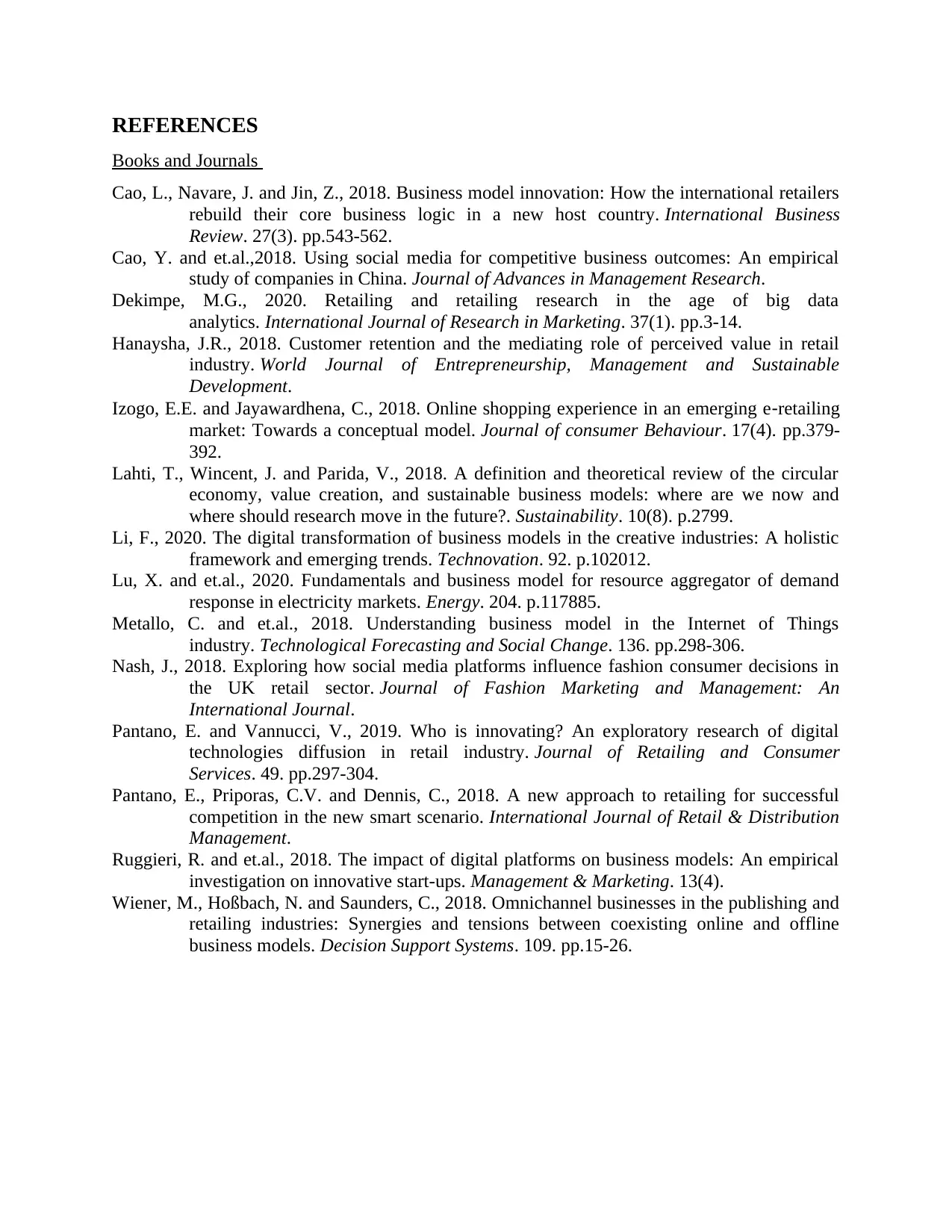
REFERENCES
Books and Journals
Cao, L., Navare, J. and Jin, Z., 2018. Business model innovation: How the international retailers
rebuild their core business logic in a new host country. International Business
Review. 27(3). pp.543-562.
Cao, Y. and et.al.,2018. Using social media for competitive business outcomes: An empirical
study of companies in China. Journal of Advances in Management Research.
Dekimpe, M.G., 2020. Retailing and retailing research in the age of big data
analytics. International Journal of Research in Marketing. 37(1). pp.3-14.
Hanaysha, J.R., 2018. Customer retention and the mediating role of perceived value in retail
industry. World Journal of Entrepreneurship, Management and Sustainable
Development.
Izogo, E.E. and Jayawardhena, C., 2018. Online shopping experience in an emerging e‐retailing
market: Towards a conceptual model. Journal of consumer Behaviour. 17(4). pp.379-
392.
Lahti, T., Wincent, J. and Parida, V., 2018. A definition and theoretical review of the circular
economy, value creation, and sustainable business models: where are we now and
where should research move in the future?. Sustainability. 10(8). p.2799.
Li, F., 2020. The digital transformation of business models in the creative industries: A holistic
framework and emerging trends. Technovation. 92. p.102012.
Lu, X. and et.al., 2020. Fundamentals and business model for resource aggregator of demand
response in electricity markets. Energy. 204. p.117885.
Metallo, C. and et.al., 2018. Understanding business model in the Internet of Things
industry. Technological Forecasting and Social Change. 136. pp.298-306.
Nash, J., 2018. Exploring how social media platforms influence fashion consumer decisions in
the UK retail sector. Journal of Fashion Marketing and Management: An
International Journal.
Pantano, E. and Vannucci, V., 2019. Who is innovating? An exploratory research of digital
technologies diffusion in retail industry. Journal of Retailing and Consumer
Services. 49. pp.297-304.
Pantano, E., Priporas, C.V. and Dennis, C., 2018. A new approach to retailing for successful
competition in the new smart scenario. International Journal of Retail & Distribution
Management.
Ruggieri, R. and et.al., 2018. The impact of digital platforms on business models: An empirical
investigation on innovative start-ups. Management & Marketing. 13(4).
Wiener, M., Hoßbach, N. and Saunders, C., 2018. Omnichannel businesses in the publishing and
retailing industries: Synergies and tensions between coexisting online and offline
business models. Decision Support Systems. 109. pp.15-26.
Books and Journals
Cao, L., Navare, J. and Jin, Z., 2018. Business model innovation: How the international retailers
rebuild their core business logic in a new host country. International Business
Review. 27(3). pp.543-562.
Cao, Y. and et.al.,2018. Using social media for competitive business outcomes: An empirical
study of companies in China. Journal of Advances in Management Research.
Dekimpe, M.G., 2020. Retailing and retailing research in the age of big data
analytics. International Journal of Research in Marketing. 37(1). pp.3-14.
Hanaysha, J.R., 2018. Customer retention and the mediating role of perceived value in retail
industry. World Journal of Entrepreneurship, Management and Sustainable
Development.
Izogo, E.E. and Jayawardhena, C., 2018. Online shopping experience in an emerging e‐retailing
market: Towards a conceptual model. Journal of consumer Behaviour. 17(4). pp.379-
392.
Lahti, T., Wincent, J. and Parida, V., 2018. A definition and theoretical review of the circular
economy, value creation, and sustainable business models: where are we now and
where should research move in the future?. Sustainability. 10(8). p.2799.
Li, F., 2020. The digital transformation of business models in the creative industries: A holistic
framework and emerging trends. Technovation. 92. p.102012.
Lu, X. and et.al., 2020. Fundamentals and business model for resource aggregator of demand
response in electricity markets. Energy. 204. p.117885.
Metallo, C. and et.al., 2018. Understanding business model in the Internet of Things
industry. Technological Forecasting and Social Change. 136. pp.298-306.
Nash, J., 2018. Exploring how social media platforms influence fashion consumer decisions in
the UK retail sector. Journal of Fashion Marketing and Management: An
International Journal.
Pantano, E. and Vannucci, V., 2019. Who is innovating? An exploratory research of digital
technologies diffusion in retail industry. Journal of Retailing and Consumer
Services. 49. pp.297-304.
Pantano, E., Priporas, C.V. and Dennis, C., 2018. A new approach to retailing for successful
competition in the new smart scenario. International Journal of Retail & Distribution
Management.
Ruggieri, R. and et.al., 2018. The impact of digital platforms on business models: An empirical
investigation on innovative start-ups. Management & Marketing. 13(4).
Wiener, M., Hoßbach, N. and Saunders, C., 2018. Omnichannel businesses in the publishing and
retailing industries: Synergies and tensions between coexisting online and offline
business models. Decision Support Systems. 109. pp.15-26.
⊘ This is a preview!⊘
Do you want full access?
Subscribe today to unlock all pages.

Trusted by 1+ million students worldwide
1 out of 14
Related Documents
Your All-in-One AI-Powered Toolkit for Academic Success.
+13062052269
info@desklib.com
Available 24*7 on WhatsApp / Email
![[object Object]](/_next/static/media/star-bottom.7253800d.svg)
Unlock your academic potential
Copyright © 2020–2025 A2Z Services. All Rights Reserved. Developed and managed by ZUCOL.





